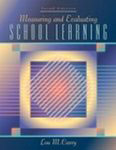
 Book Review
Book Review
 Measuring and evaluating school learning. [3rd Edition]
Measuring and evaluating school learning. [3rd Edition]
 by Lou M. Carey (2000)
by Lou M. Carey (2000) ISBN: 0-205-32388-X
ISBN: 0-205-32388-X
 Boston: Allyn & Bacon / Longman Group
Boston: Allyn & Bacon / Longman Group
 This book was designed for American grade-school teachers, but it is
of value to any teachers developing classroom tests. Though its 550
pages are difficult to read from cover to cover, it works well as a
reference aid. Since this book features practice exercises and
feedback, it could also be used as an in-service training course on test design.
This book was designed for American grade-school teachers, but it is
of value to any teachers developing classroom tests. Though its 550
pages are difficult to read from cover to cover, it works well as a
reference aid. Since this book features practice exercises and
feedback, it could also be used as an in-service training course on test design.
 Carey's work is divided into four sections. The first deals with
designing learner-centred and curriculum-centred classroom assessment
tools. The second considers different types of tests and test
purposes, explaining how to write good test items and assess tests
reliably. The third section deals with test statistic. The final
section describes different ways in which student progress can be communicated.
Carey's work is divided into four sections. The first deals with
designing learner-centred and curriculum-centred classroom assessment
tools. The second considers different types of tests and test
purposes, explaining how to write good test items and assess tests
reliably. The third section deals with test statistic. The final
section describes different ways in which student progress can be communicated.
 At the start of each chapter a list of objectives appears with an
outline of the content of the following chapter. Within each chapter,
there are lots of clear examples, tables, and charts to illustrate the
process being described. Each chapter also contains a section on how
to make the best use of computers, and the types of software which are
available. The advantages of using spreadsheets to record, calculate,
and weigh test scores are mentioned. The value of creating test
question item-banks is also highlighted. Though most of the software
mentioned in this text is not relevant to EFL teachers, the basic
information about computer literacy is. At the end of each
chapter, there are practice exercises, feedback on these exercises,
and a list of suggested readings. These consolidate the principles
explained in the book. While some exercises are not relevant to EFL
teachers, the enrichment tasks do offer readers an opportunity to apply
the material from the chapter to their own context. At the end of each
chapter a list of suggested readings is given. However, the range of
books listed is very narrow and many references are not relevant to language testing.
At the start of each chapter a list of objectives appears with an
outline of the content of the following chapter. Within each chapter,
there are lots of clear examples, tables, and charts to illustrate the
process being described. Each chapter also contains a section on how
to make the best use of computers, and the types of software which are
available. The advantages of using spreadsheets to record, calculate,
and weigh test scores are mentioned. The value of creating test
question item-banks is also highlighted. Though most of the software
mentioned in this text is not relevant to EFL teachers, the basic
information about computer literacy is. At the end of each
chapter, there are practice exercises, feedback on these exercises,
and a list of suggested readings. These consolidate the principles
explained in the book. While some exercises are not relevant to EFL
teachers, the enrichment tasks do offer readers an opportunity to apply
the material from the chapter to their own context. At the end of each
chapter a list of suggested readings is given. However, the range of
books listed is very narrow and many references are not relevant to language testing.
 The main strengths of this book are its thorough treatment of the
topic, the detailed explanations and examples and the advice to
teachers about how to put theories into practice. However, this book
is so long and detailed that at times it feels like a hard slog to
read. The book presents the ideal rather than the realistic, which
may leave a teacher either trying to do more than is realistic and
therefore overworking themselves or only doing what is realistic and
then feeling that they are failing their students and consequently
they are also failing to be good teachers (which presumably is the
opposite of the desired effect).
The main strengths of this book are its thorough treatment of the
topic, the detailed explanations and examples and the advice to
teachers about how to put theories into practice. However, this book
is so long and detailed that at times it feels like a hard slog to
read. The book presents the ideal rather than the realistic, which
may leave a teacher either trying to do more than is realistic and
therefore overworking themselves or only doing what is realistic and
then feeling that they are failing their students and consequently
they are also failing to be good teachers (which presumably is the
opposite of the desired effect).
 At the end of the day, this book contains a wealth of information and
the more the teacher refers back to the book with specific questions,
as and when they arise, the more they will learn about good testing
practice.
At the end of the day, this book contains a wealth of information and
the more the teacher refers back to the book with specific questions,
as and when they arise, the more they will learn about good testing
practice.
Reviewed by Yvonne Ishida
